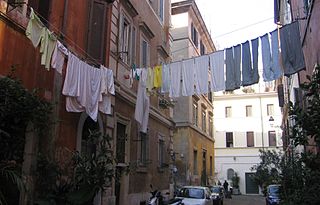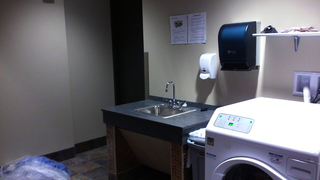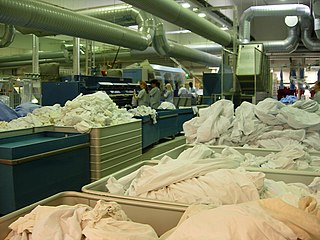Related Research Articles

Laundry refers to the washing of clothing and other textiles, and, more broadly, their drying and ironing as well. Laundry has been part of history since humans began to wear clothes, so the methods by which different cultures have dealt with this universal human need are of interest to several branches of scholarship.

A laundry symbol, also called a care symbol, is a pictogram indicating the manufacturer's suggestions as to methods of washing, drying, dry-cleaning and ironing clothing. Such symbols are written on labels, known as care labels or care tags, attached to clothing to indicate how a particular item should best be cleaned. While there are internationally recognized standards for the care labels and pictograms, their exact use and form differ by region. In some standards, pictograms coexist with or are complemented by written instructions.

A washing machine is a home appliance used to wash laundry. The term is mostly applied to machines that use water as opposed to dry cleaning or ultrasonic cleaners. The user adds laundry detergent, which is sold in liquid, powder, or dehydrated sheet form, to the wash water.

A clothes dryer, also known as tumble dryer or simply dryer, is a powered household appliance that is used to remove moisture from a load of clothing, bedding and other textiles, usually after they are washed in a washing machine.

A laundry room is a room where clothes are washed and dried. In a modern home, a laundry room would be equipped with an automatic washing machine and clothes dryer, and often a large basin, called a laundry tub, for hand-washing delicate articles of clothing such as sweaters, and an ironing board. A typical laundry room is located in the basement of older homes, but in many modern homes, the laundry room might be found on the main floor near the kitchen or upstairs near the bedrooms.

A clothes line, also spelt clothesline and also known as a washing line, is a device for hanging clothes on for the purpose of drying them. It is any type of rope, cord, or twine that has been stretched between two points, outside or indoors, above the level of the ground. Clothing that has recently been washed is hung along the line to dry, using clothes pegs or clothespins. Washing lines are attached either from a post or a wall, and are frequently located in back gardens, or on balconies. Longer washing lines often have props holding up sections in the middle due to the weight of the usually wet clothing.
A fabric softener or fabric conditioner is a conditioner that is applied to laundry after it has been washed in a washing machine. A similar, more dilute preparation meant to be applied to dry fabric is known as a wrinkle releaser.

A laundry ball or washing ball is a product made of solid, insoluble material promoted as a substitute for laundry detergent. Producers of laundry balls often make pseudoscientific claims about their mechanisms of action and exaggerate the extent of their benefits.

A combo washer dryer is a combination in a single cabinet of a washing machine and a clothes dryer. It should not be confused with a "stackable" combination of a separate washing machine and a separate clothes dryer.

A self-service laundry, coin laundry, or coin wash, is a facility where clothes are washed and dried without much personalized professional help. They are known in the United Kingdom as launderettes or laundrettes, and in the United States, Canada, Australia and New Zealand as laundromats. In Texas and other parts of the south central United States, the term washateria is still used by some older speakers.

Ironing is the use of an iron, usually heated, to remove wrinkles and unwanted creases from fabric. The heating is commonly done to a temperature of 180–220 °Celsius, depending on the fabric. Ironing works by loosening the bonds between the long-chain polymer molecules in the fibres of the material. While the molecules are hot, the fibres are straightened by the weight of the iron, and they hold their new shape as they cool. Some fabrics, such as cotton, require the addition of water to loosen the intermolecular bonds. Many modern fabrics are advertised as needing little or no ironing. Permanent press clothing was developed to reduce the ironing necessary by combining wrinkle-resistant polyester with cotton.

A domestic robot is a type of service robot, an autonomous robot that is primarily used for household chores, but may also be used for education, entertainment or therapy. While most domestic robots are simplistic, some are connected to Wi-Fi home networks or smart environments and are autonomous to a high degree. There were an estimated 16.3 million service robots in 2018.
Dimensional stability pertains to a fabric's ability to maintain its initial size and shape even after undergoing wear and care, which is a desirable property. Dimension stability in fabrics or Shrinkage is the change of dimensions in textile products when they are washed or relaxed. The change is always expressed relative to the dimensions before the exposure of washing or relaxing. Shrinkage is also called residual shrinkage and measured in percentage. The major cause of shrinkages is the release of stresses and strains introduced in manufacturing processes. Textile manufacturing is based on the conversion of fiber into yarn, yarn into fabric, includes spinning, weaving, or knitting, etc. The fabric passes through many inevitable changes and mechanical forces during this journey. When the products are immersed in water, the water acts as a relaxing medium, and all stresses and strains are relaxed and the fabric tries to come back to its original state.

Kenmore is an American brand of household appliances, cookware, floorcare, grills, HVAC equipment and other home items owned and licensed by Transformco, an affiliate of ESL Investments. Previously they were a subsidiary brand of Sears Holdings, but after Sears Holdings filed for Chapter 11 bankruptcy on October 15, 2018 they were acquired by Transformco, formed in 2019 after acquiring the assets of Sears Holdings Corporation.
FoldiMate was a California-based company developing a robotic laundry-folding machine founded in 2012. Their clothes folding machine was aimed to enter the market by the end of 2019. In 2021, the company folded.

A laundry-folding machine or laundry-folding robot is a machine or domestic robot which folds apparel such that they can be stored compactly and orderly.

Washio was an American on-demand laundry cleaning and delivery service. The company was founded in 2013 by Jordan Metzner, Bob Wall, and Juan Dulanto, and raised $17 million in funding.
Poplin is an American company which allows people to hire independent contractors to wash, dry, fold, and deliver laundry. SudShare was co-founded in 2018 by Mort and Nachshon Fertel in Baltimore, Maryland, and operates through a mobile app of the same name. The service is available in over 400 American cities.
References
- ↑ "Meet 'Laundroid' — the world's first laundry folding robot". CNBC. Archived from the original on 2021-08-27. Retrieved 2021-08-27.
- ↑ "Laundroid Laundry-Folding Robot Maker Raises $60M". Robotics Trend. 18 November 2016. Archived from the original on 2022-09-29. Retrieved 2016-11-19.
- ↑ Craine, Tatiana (11 October 2015). "Laundroid, the Laundry-Folding Robot, Is Your New Favorite Time-Saving Invention". Inverse. Archived from the original on 2016-11-20. Retrieved 2016-11-19.
- ↑ Heater, Brian. "And Then There's Laundroid, The Laundry Folding Robot". Tech Times. Archived from the original on 2022-09-29. Retrieved 2016-11-18.
- ↑ McGrath, Jenny (5 October 2016). "Laundry-folding robot may take hours, but at least you don't have to fold laundry". Digital Trends. Archived from the original on 2016-11-19. Retrieved 2016-11-18.
- ↑ Lee, Dami (2019-04-23). "The company behind the $16,000 AI-powered laundry-folding robot has filed for bankruptcy". The Verge. Archived from the original on 2019-08-07. Retrieved 2019-08-07.